
The Illinois Central Railroad, sometimes called the Main Line of Mid-America, was a railroad in the Central United States. Its primary routes connected Chicago, Illinois, with New Orleans, Louisiana, and Mobile, Alabama, and thus, the Great Lakes to the Gulf of Mexico. Another line connected Chicago west to Sioux City, Iowa (1870), while smaller branches reached Omaha, Nebraska (1899) from Fort Dodge, Iowa, and Sioux Falls, South Dakota (1877), from Cherokee, Iowa. The IC also ran service to Miami, Florida, on trackage owned by other railroads.

The Michigan Central Railroad was originally chartered in 1832 to establish rail service between Detroit, Michigan, and St. Joseph, Michigan. The railroad later operated in the states of Michigan, Indiana, and Illinois in the United States and the province of Ontario in Canada. After about 1867 the railroad was controlled by the New York Central Railroad, which later became part of Penn Central and then Conrail. After the 1998 Conrail breakup, Norfolk Southern Railway now owns much of the former Michigan Central trackage.

Carbondale station is an Amtrak intercity train station in Carbondale, Illinois, United States. The southern terminus of Amtrak's Illini and Saluki routes, it is also served by the City of New Orleans. Amtrak Thruway service between Carbondale and St. Louis, Missouri connects with the City of New Orleans. Carbondale is the southernmost Amtrak station in Illinois.

Amboy station is a former rail station in the city of Amboy, Lee County, Illinois, United States. The building was constructed as a headquarters building for the Illinois Central Railroad as well as a public train station for the fledgling city of Amboy in 1876. It was designed by railroad staff architect James Nocquet after a fire destroyed the original Illinois Central offices on the site. The building was added to the U.S. National Register of Historic Places in 1992 as the Amboy Illinois Central Depot.

The Chicago, Milwaukee, St. Paul and Pacific Railroad Depot and Lunchroom are two buildings located in Wells, Minnesota, and built by the Chicago, Milwaukee, St. Paul and Pacific Railroad in 1903.

The Burlington, Cedar Rapids and Northern Railway (BCR&N) was a railroad that operated in the United States from 1876 to 1903. It was formed to take over the operations of the bankrupt Burlington, Cedar Rapids and Minnesota Railway, which was, in turn, the result of merging several predecessor lines, the construction of which began in 1869. The corporate headquarters were in Cedar Rapids, Iowa, and it had operations in Iowa and in Minnesota. It was succeeded by the Chicago, Rock Island and Pacific Railway.
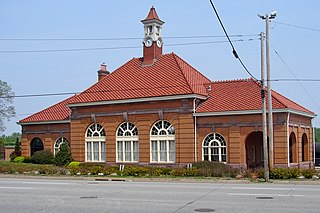
The Rock Island Lines Passenger Station, also known as Abbey Station, is a historic building located in Rock Island, Illinois, United States. It ceased operating as a railway station in 1980. The building was listed on the National Register of Historic Places in 1982, and it was designated a Rock Island landmark in 1987.
The Chicago and North Western Passenger Depot is a historic building located in Wall Lake, Iowa, United States. Wall Lake was served by both the Chicago & North Western Railroad and the Illinois Central Railroad, which gave it a significant rail presence from the 1880s until World War II. The C&NW depot is an example of a combination station plan. The plan combined both passenger and freight services in one building. They were commonly used during the heyday of railroad growth round the turn of the 20th century. However, the old Wall Lake C&NW depot was moved and used for freight. What would have been the freight room was used here for a lunchroom. C&NW had three standard combination depot plans that have been attributed to the prominent Chicago architectural firm of Frost & Granger. The Wall Lake depot was the largest of the three as it incorporated a women's waiting room, but it was actually 9 feet (2.7 m) shorter than the general plan because freight was processed in another facility. The depot was built in 1899 by A.H. Carter & Co. of Cedar Rapids, Iowa as a replacement depot. The single-story frame structure is the only building used as a depot that remains in town. It was listed on the National Register of Historic Places in 2003.

The Chicago, Milwaukee & St. Paul Depot-Jefferson, also known simply as the Milwaukee Depot is an historic building located in Jefferson, Iowa, United States. The rail line that this station served was built by the Wabash, St. Louis and Pacific Railway in either 1882 or 1883. It was part of the 500 miles (800 km) of track developed by Jay Gould in Iowa. Known as the High Bridge Route because of the height of the bridge over the Des Moines River, it was acquired by the Des Moines, Northern and Western Railroad in 1891. Four years later the Chicago, Milwaukee and St. Paul Railway acquired the line. The Milwaukee Road built this train station from their standard building plan between 1906 and 1909. It is almost identical to the station built in 1906 in Adel, Iowa. This passenger station replaced a combination passenger and freight depot that was moved and used solely as a freight depot. The Milwaukee Road discontinued passenger service in Jefferson in the early 1950s, and the depot continued as a freight office until 1980. The building was listed on the National Register of Historic Places in 1994.
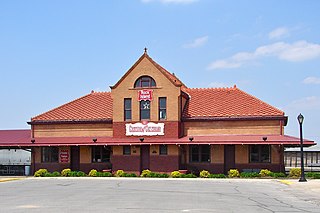
The Chicago, Rock Island & Pacific Railroad Depot, also known as the Rock Island Depot, is an historic building located in Atlantic, Iowa, United States. The Chicago, Rock Island & Pacific Railroad built the first tracks through the area in 1868. The city of Atlantic was founded at the time of the railroad construction. It grew to become the largest and the most significant community along the Rock Island lines between Des Moines and Council Bluffs. The present depot dates from 1898, and it is not a standard-plan depot for the railroad. The unusual design suggests it is the work of an architect, possibly from Chicago. It was built during a prosperous period for the railroad when it was able to replace its facilities along its mainline. The express freight and baggage building attached to the depot was built at the same time. The passenger depot replaced a frame combination passenger and freight depot a block away.

The Chicago and North Western Office Building/Passenger Depot-Lake City, also known as the Lake City Depot, is a historic building located in Lake City, Iowa, United States. The Toledo & North Western Railroad (TNW) laid the first tracks through town in 1881–1882. Because Lake City was already established, they built a two-story, frame, combination depot and the southeast edge of town. Because of its convenient location, the TNW also built their repair and maintenance shops in Lake City in the 1880s. They placed their division headquarters here in 1887. The Chicago and North Western Railway (CNW) acquired controlling interest in the TNW in June 1881, and ran it separately until it formally acquired it in 1890.

The Chicago, Rock Island and Pacific Passenger Depot-Pella, also known as the Pella Depot and the Rolscreen Museum, is a historic building located in Pella, Iowa, United States. The Des Moines Valley Railroad built the first tracks through the area in 1865, and they built a simple frame depot to serve passenger's needs. For 10 years, Pella served as the only rail stop in Marion County until a competing station was built in Knoxville, Iowa by the Chicago, Burlington, and Quincy Railroad. The Chicago, Rock Island & Pacific Railroad leased the Des Moines Valley's tracks beginning in 1878 and provided freight service through 1980. The old frame building was replaced, in 1906, with a single story, brick depot–a conventional building style for the railroad. The new, brick depot served as a passenger station until the latter 1940s. The last passenger service was as a stop on a short line motor train service between Eldon in southeast Iowa and Des Moines. The station was freight only by 1949.

The Sac City Chicago and North Western Depot is a historic building located in Sac City, Iowa, United States. The city was platted in 1855, and soon after they began to campaign for a rail line into the town. It took 23 years before the railroad arrived. The Maple River Railroad was the first to lay tracks in Sac County in 1877, but it went to Wall Lake rather than Sac City. The Sac City & Wall Lake Railroad was formed that year and the tracks were laid between the two towns in 1878. The Chicago & North Western Railroad acquired the line in 1884, and built a two-story frame depot in Sac City. The business district grew up around the depot. In 1916 the Chicago & North Western replaced the frame depot with this single story brick depot a block to the south. It was a combination depot, passenger and freight, that utilized Chicago & North Western's Number One standard plan.
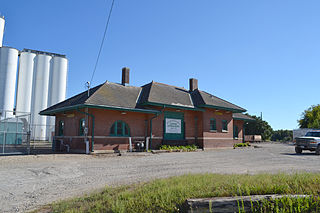
Iowa Falls Union Depot is a historic building located in Iowa Falls, Iowa, United States. The Dubuque & Sioux City Railroad, an affiliate of the Illinois Central Railroad (IC), laid the first rail track to Iowa Falls in 1866. The following year the Iowa Falls & Sioux City Railroad, another IC affiliate, continued construction of the line to the west, and it reached Sioux City by 1870. They built a plain, two-story frame depot to serve Iowa Falls. The Burlington, Cedar Rapids and Northern Railway (BCR&N) by way of its affiliate the Cedar Rapids, Iowa Falls & North Western, entered Iowa Falls in 1880. They built their own depot. It was basically another east–west route, but local business leaders desired a north–south route to serve the community.
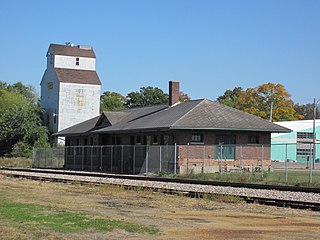
Illinois Central Combination Depot-Ackley is a historic building located in Ackley, Iowa, United States. The Dubuque & Sioux City Railroad, an affiliate of the Illinois Central Railroad (IC), laid the first rail track to Iowa Falls in 1865. Two years later the Iowa Falls & Sioux City Railroad, another IC affiliate, continued construction of the line to the west, and it reached Sioux City by 1870. They built a plain, two-story frame depot to serve Ackley. From the 1890s to the 1920s the IC replaced its first generation stations with new brick structures. IC architect J.H. Schott designed the new depot at Ackley, and it was built by Coomer & Small Construction Company of Sioux City. The long and low single-story brick building exhibits influences from the Prairie School and the Tudor Revival style. A combination depot is one that incorporates passenger and freight services in the same building. It was also an island depot, meaning that it sat in the middle of the tracks. It was one of the last replacement depots the IC built before the Great Depression. The building was listed on the National Register of Historic Places in 1990.

The Chicago Great Western Railroad-Waterloo Freight Depot is a historic building located in Waterloo, Iowa, United States. In 1887 the Chicago, St. Paul & Kansas City Railroad (CSP&KC) was the third system to enter the city, after the Illinois Central (1870) and the Burlington, Cedar Rapids and Northern Railway (1876). The CSP&KC was the first of the three to put its depots in the downtown area. Initially it built two depots in Waterloo, one on the west side of the Cedar River and one on the east side. By 1892 it had built separate passenger and freight depots along East Sixth Street. That was the same year that the CSP&KC became known as the Chicago Great Western Railroad. In 1903 the railroad built new passenger and freight depots a block south, moving them closer to the city's wholesale houses. The two-story concrete block freight depot was built on a rough limestone foundation. It features round arch freight doors and a simple wood cornice. The concrete block addition on the southeast side replaced a frame gabled structure, but its construction date is unknown. The old brick passenger depot was torn down in 1973, and the freight depot was listed on the National Register of Historic Places in 1997. In 2001 the building, which is owned by the City of Waterloo, was leased to the University of Northern Iowa for its Center for Urban Education (UNI-CUE).
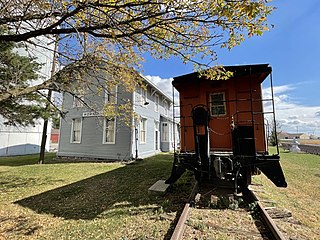
The Chicago, Milwaukee, St. Paul & Pacific Combination Depot-Hornick, also known as the Hornick Depot, is a historic building located in Hornick, Iowa, United States. The town was patted by the Chicago, Milwaukee, St. Paul & Pacific Railroad's land company when the railroad created a branch line from Manilla, Iowa to Sioux City. Completed in 1887, the railroad built this two-story frame structure to serve as its passenger and freight depot. It is one of six such depots that remain in Iowa, and the best preserved. These buildings were built from a standard design used by the railroad. The two-story stations included living quarters for the station manager because the towns had yet to develop when the depot was built. This was an island depot, with freight loaded on the north side and passengers boarded on the south. Decorative elements on this depot include lathe-turned wooden finials, angled wooden brackets, and bracketed door and window hoods. Passenger service ended in the 1950s, and grain was loaded here until 1980 when the Milwaukee Road abandoned the Sioux City branch line. The building was listed on the National Register of Historic Places in 1990. It has been converted into a local history museum.
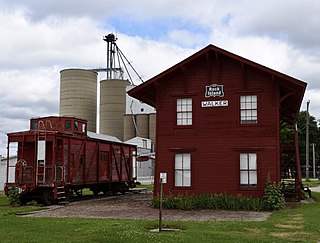
Walker Station is a historic building located in Walker, Iowa, United States. The two-story frame building with bracketed eaves was completed in 1873 along the Burlington, Cedar Rapids, and Minnesota Railway tracks. The depot also served its successor railroads: the Burlington, Cedar Rapids and Northern, and the Chicago, Rock Island and Pacific. Typical of many railroad towns in the Midwest, this is the first building that was built here and the town grew up around it. It is an example of a combination depot that was used for both passenger and freight usage in smaller communities. Because it has a ground level brick platform, service here was primary passenger and light freight service. A higher level of freight service would have required a raised platform.

The Milwaukee and St. Paul Railway Combination Depot is a historic building located in Decorah, Iowa, United States. After the Milwaukee and St. Paul Railroad, later the Chicago, Milwaukee, St. Paul and Pacific Railroad, choose a different route for their north–south mainline, community leaders convinced them to build a spur to Decorah. This would open the town to larger markets to ship the products produced there. The tracks were completed in 1869, and a boxcar served as the first depot. That same year this single-story, wood-frame structure with Greek Revival features was completed south of the central business district. It served as a combination depot, servicing both passengers and freight. After the arrival of the Chicago, Rock Island and Pacific Railroad in 1884 the Milwaukee Road started to plan a new passenger depot in Decorah. It was completed on the east end of the main commercial street in 1888. When it opened, this building continued to serve as a freight depot. Over the years its platforms were shortened, and sometime between the 1930s and the 1950s, the southwest end of the building was shortened. The Milwaukee Road abandoned the depot in 1971, and the tracks that flanked the building were removed the same year. The former depot itself was renovated for non-railroad use. This is believed to be a rare extant example of a wooden combination depot in Iowa. The building was listed on the National Register of Historic Places in 2016.
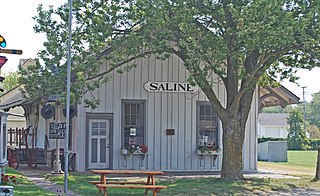
The Saline station, also known as the Detroit, Hillsdale and Indiana Railroad-Saline Depot, is a former railroad depot located at 402 North Ann Arbor Street in Saline, Michigan. It was listed on the National Register of Historic Places in 1994. The building now houses the Saline Depot Museum.






















